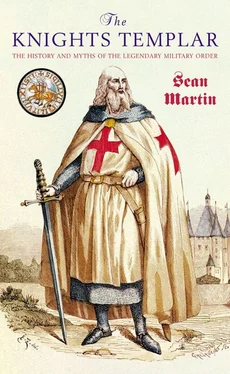Sean Martin - The Knights Templar
Здесь есть возможность читать онлайн «Sean Martin - The Knights Templar» весь текст электронной книги совершенно бесплатно (целиком полную версию без сокращений). В некоторых случаях можно слушать аудио, скачать через торрент в формате fb2 и присутствует краткое содержание. Год выпуска: 2004, ISBN: 2004, Жанр: История, на английском языке. Описание произведения, (предисловие) а так же отзывы посетителей доступны на портале библиотеки ЛибКат.
- Название:The Knights Templar
- Автор:
- Жанр:
- Год:2004
- ISBN:1-904048-28-5
- Рейтинг книги:3 / 5. Голосов: 1
-
Избранное:Добавить в избранное
- Отзывы:
-
Ваша оценка:
- 60
- 1
- 2
- 3
- 4
- 5
The Knights Templar: краткое содержание, описание и аннотация
Предлагаем к чтению аннотацию, описание, краткое содержание или предисловие (зависит от того, что написал сам автор книги «The Knights Templar»). Если вы не нашли необходимую информацию о книге — напишите в комментариях, мы постараемся отыскать её.
The Knights Templar — читать онлайн бесплатно полную книгу (весь текст) целиком
Ниже представлен текст книги, разбитый по страницам. Система сохранения места последней прочитанной страницы, позволяет с удобством читать онлайн бесплатно книгу «The Knights Templar», без необходимости каждый раз заново искать на чём Вы остановились. Поставьте закладку, и сможете в любой момент перейти на страницу, на которой закончили чтение.
Интервал:
Закладка:
Innocent also directly addressed the Order, warning its members not to abuse any of their privileges, knowing full well that they were often accused of the sin of pride. He complained that they gave full Christian burial to anybody, as long as they had some money to pay for it, not bothering to find out whether they had been excommunicated or had some other reason for not being allowed to be laid to rest in consecrated ground. In prophetic words, Innocent warned the Order that if they did not change their ways, they would become agents of the Devil.
The Other Military Orders
One unexpected development in the Latin East after the end of the Third Crusade was the establishment of a new military order. In 1197, German crusaders had arrived in the East; they were largely unsuccessful, their sole military contribution being their participation in the capture of Beirut that year. Most of the German crusaders returned home, but a number of knights remained in the East, and joined a field hospital that had been set up in 1190 by merchants from Bremen and Lübeck. During the siege of Acre in 1191 they were said to have welcomed brothers from the Hospital of St Mary of the Germans, which, tradition holds, was founded in Jerusalem in 1127. The new hospital’s first base in Acre was a tent on the shore made from a ship’s mainsail. When the knights joined, they became the Teutonic Knights of St Mary’s Hospital of Jerusalem, and on 5 March 1198, the Teutonic Knights were accepted as an order of the church at the Temple compound in Acre.
The Teutonic Knights were the last of the three great military orders to be founded. The first of them, the Hospitallers, had been founded before the formation of the Templars, sometime around 1070. The Hospital – founded by a group of merchants from Amalfi – was originally that of St John the Almoner, and it operated an infirmary and guest house for pilgrims near the Church of Holy Sepulchre. The first Grand Master was Peter Gerard, who was elected in about 1100. As soon as the Kingdom of Jerusalem was established, Godfroi de Bouillon donated lands to the Order, and many others followed suit, with the result that the Hospitallers had extensive holdings in Europe as well as the East. The capture of Jerusalem in 1099 led naturally to the influx of a greater number of pilgrims than ever, and it was decided that a more prominent patron saint should be adopted for the Order: John the Almoner was replaced by John the Baptist. The Hospital was recognised as an order by Pope Paschal II (1099–1118) in 1113.
The Order’s second Grand Master, Raymond de Puy, oversaw the Hospital’s adoption of an increasingly military role. In the early years, it is possible that Templars were used to guard the Hospital’s establishments, but during the 1120s it seems that the Hospitallers themselves started to militarise. A Hospitaller constable is mentioned in documents dating from 1126, 19 19 Seward, The Monks ofWar (Penguin Books, 1992), p.37.
but the first firm date for military activity is 1136, when King Fulk gave the Order the castle of Gibelin, on the Gaza–Hebron road. Like the Templars, the Hospitallers received papal privileges: Innocent II (1130–43) forbade bishops to interdict Hospitaller chapels; Anastasius IV (1153–54) gave them their own priests; while Adrian IV (1154–59) gave them their own churches. Their rule evolved slowly, with Raymond being guided by pragmatic concerns. Like the Teutonic Knights after them, some of the Hospital’s statutes were modelled on those of the Templars.
In addition to the Hospital and the Teutonic Knights, there were several smaller orders active in the East. The Hospital of St Lazarus was the third military order to be founded after the Temple and the Hospital of St John. Originating probably from a Greek or Armenian leper house in Jerusalem, the Order was set up solely for knights who had contracted leprosy. It was taken over by the Hospital of St John during the early 1100s, and it is said that the first Hospitaller Grand Master, Peter Gerard, also acted as the Grand Master of St Lazarus. According to legend, all their subsequent Grand Masters were lepers. They established a chain of houses for lepers across the East and Europe, which became known as ‘Lazar Houses’, and were chiefly known for their hospitaller work, although they participated in a number of engagements in the East alongside the Templars and Hospitallers. The Templar Rule demanded that a brother who caught leprosy must transfer to the Order of St Lazarus. 20 20 The connection between Lazarus and leprosy is a mysterious one. Lazarus, in John’s Gospel, did not suffer from the disease. It is possible that the Templars used Lazar houses for purposes other than that of treating lepers, knowing that fear of the disease would mean that the houses would remain undisturbed.
The Knights of Our Lady of Montjoie were recognised as an order by a bull issued by Pope Alexander III (1159–81) in 1180. The Order was founded by a Spanish knight, Count Rodrigo, taking its name from the castle of Montjoie just outside of Jerusalem (the name itself deriving from the cries of joy that pilgrims were said to have uttered upon first seeing the Holy City). The Order – never numerous at the best of times – seemed to have had trouble gaining recruits, and, after the disasters of 1187, the surviving brothers retired to Aragon, where they changed their name to the Order of Trufac.
The Hospitallers of St Thomas of Canterbury, also known as the Knights of St Thomas Acon, were founded around the same time as the Teutonic Knights. Their origins were also from the time of the Third Crusade: William, the Dean of St Paul’s, was so moved by the plight of the English crusaders that, after the capture of Acre in 1191, he bought a small chapel and cemetery. The hospital that he founded was restricted to Englishmen, although many preferred to join the Templars and the Hospitallers instead. Like their better-known contemporaries, they received donations of land in the East and in Europe. They are thought to have militarised around the time of the Fifth Crusade.
Military Tactics
The Templars’ reputation in the field was unsurpassed. When the Franks were crushed at Hattin, Saladin ordered that all the captive Templars and Hospitallers be executed, such was his conviction that the military orders were the Franks’ main weapon against Islam. (Indeed, Saladin viewed the two orders as ‘impure races’. 21 21 Barber, op. cit. , p.64.
)
The Templars – as did the secular Franks – employed cavalry and infantry. The former comprised mounted knights and sergeants, the latter archers and troops armed with axes and spears. The knights were the mediaeval equivalent of a tank, with their great war horses often standing up to 17 hands high. The horses – known as destriers – were taught to kick, butt and bite. The sergeants were also mounted, but wore lighter armour and rode in the rear.
Tactics were simple, but, when timed properly, were devastatingly effective. Initially, the infantry would provide cover, before the cavalry charge, which would form the main attack. A properly timed charge would wipe out everything in its path; misjudged charges led to disasters such as the Springs of Cresson. During the melée, the Templars were sworn to stay in the field as long as the Order’s distinctive black and white banner, known as the beauseant , remained aloft. As soon as the beauseant was lost to sight, the Templars would rally to the Hospitaller banner or, if that too was down, then any remaining Christian banner. Their vows meant that they were usually the first into the field, and the last to leave.
In the early years of the Latin East, the Templars quickly developed a fearsome reputation as the best-trained soldiers the Franks had, showing almost suicidal bravery at times. This reached an apogee during the Mastership of Gerard de Ridefort, who died during a reckless attack at Acre. However, as the twelfth century gave way to the thirteenth, the Templars began to retreat from their earlier zeal and grew ever more cautious in battle.
Читать дальшеИнтервал:
Закладка:
Похожие книги на «The Knights Templar»
Представляем Вашему вниманию похожие книги на «The Knights Templar» списком для выбора. Мы отобрали схожую по названию и смыслу литературу в надежде предоставить читателям больше вариантов отыскать новые, интересные, ещё непрочитанные произведения.
Обсуждение, отзывы о книге «The Knights Templar» и просто собственные мнения читателей. Оставьте ваши комментарии, напишите, что Вы думаете о произведении, его смысле или главных героях. Укажите что конкретно понравилось, а что нет, и почему Вы так считаете.












